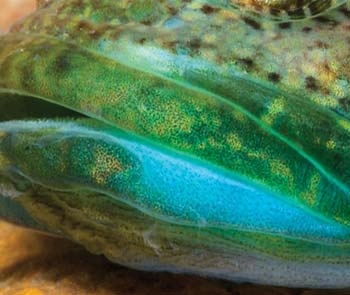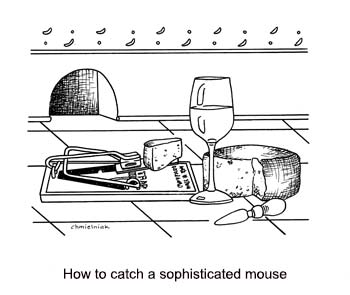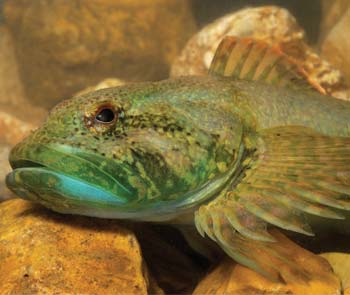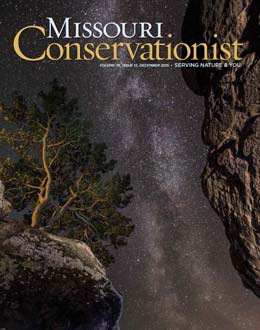What Is It?
Our photographers have been busy exploring the intricacies of outdoor Missouri. See if you can guess this month’s natural wonder.

Ask MDC
- Address: PO Box 180, Jefferson City, MO 65102-0180
- Phone: 573-522-4115, ext. 3848
- Email: AskMDC@mdc.mo.gov
Q. I have a tough time distinguishing between red-tailed and red-shouldered hawks. What is the best way to identify each species?
A. Twelve species of hawks, kites, vultures, osprey, and the bald eagle nest and raise their young in Missouri. Two other birds of prey only visit during the winter months. And five extremely rare species are seen only once or twice a decade. But two of the most common species, the red-tailed hawk and the red-shouldered hawk, are sometimes hard to differentiate. When trying to make an accurate identification, consider where you saw the hawk.
Red-tailed hawks often rest atop telephone poles and other elevated perches, hunting small mammals in open fields and along roadsides. In comparison, red-shouldered hawks prefer to hunt prey — rodents, crayfish, reptiles, and amphibians — in forested areas near the rivers and streams. Another clue is the size of the bird. Averaging 22 inches in height with a 50-inch wingspan, red-tailed hawks are larger than red-shouldered hawks, which range between 15 and 19 inches and have a 40-inch wingspan.
Seen perched from behind, red-tailed hawks have a stippling of white scapular feathers in the shape of a broad V located on the sides of the back. Red-shouldered hawks have a checkerboard of salt-and-pepper feathers on their backs, with the rusty shoulders that give them their name.
From the front, red-tailed hawks have a white chest with a band of dark streaks on its belly. Adult red-shouldered hawks have rusty bars from their bellies to their throats. The tails also have a tale to tell. The red-tailed hawk’s name is a clue, because this raptor’s tail fan is rusty-red when seen from both below and above. (The tail fan also is marked by a black band near the tip, called a sub-terminal band.) In comparison, red-shouldered hawks have black tails marked by narrow white bands.
Red-shouldered hawks also have narrower and longer tails. And unlike a red-tailed hawk — whose wingtips extend almost the length of their tail feathers — a perched red-shouldered hawk’s tail extends well beyond the tips of the folded wings.
Q. What kind of fungi is this? It’s located on a dead tree along the Perry County Community Lake hiking trail.
A. This fungus is commonly known as a cracked-cap polypore (Phellinus robiniae). Phellinus refers to the “corky” nature of the conk, a type of mushroom, and robiniae means “growing on black locust trees,” which is fitting since these fungi have a cork-like texture and almost always are associated with black locusts. Johann Bruhn, University of Missouri professor emeritus, noted a black locust’s heartwood — the older, nonliving interior wood of the tree — is typically highly resistant to decay.
“But Phellinus robiniae has evolved mechanisms to overcome this resistance,” he noted. “It has found its niche in this regard.”
The inedible mushroom infects the tree through wounds and dead branch stubs. Although some might lament the damage it causes the tree, Bruhn views it as part of its life cycle.
Cracked-cap polypores are perennial, increasing in size each year for up to a decade or more. When young, the conks appear velvety. The flesh tends to be reddish-brown to yellowish-brown. As they age, it’s not uncommon to see cracked-caps become hosts to colonies of lichens and moss on their fissured upper surfaces.

Agent Notes
Pass it On Down
One of my favorite country songs is “Pass It On Down” by Alabama. More like a conservation anthem than a traditional country song, it touches on several current environmental issues and the consequences we face if changes do not occur. The chorus of the song directly challenges us all to step up and do our part:
“So let’s leave some blue up above us Let’s leave some green on the ground It’s only ours to borrow, let’s save some for tomorrow Leave it and pass it on down.”
Hunters and anglers help do their part to “pass it on down” every time they purchase their hunting or fishing permits. In addition, federal excise taxes on firearms, ammunition, and fishing equipment help fund state wildlife agencies. Conservation groups help stretch funding and often support additional staff to help private landowners or with public land management. With the help of these organizations, thousands of acres of habitat have been restored, purchased, and managed. As a result, thousands of people each year are introduced to the outdoors through special programs for families, kids, women, and the disabled.
I challenge everyone to join a conservation organization, give back more than you take, and pass it on down.
Kevin Zielke is the conservation agent for Johnson County. If you would like to contact the agent for your county, phone your regional conservation office.
What Is It?
Ozark Sculpin
Cottus hypselurus
 The Ozark sculpin is one of at least 14 fish species that are endemic to the Ozark Region of southern Missouri and Arkansas, meaning they occur nowhere else in the world. It requires coldwater habitats, occurring almost exclusively in branches and streams that receive much of their flow from springs. It is found in riffles as well as pools, over bottom types ranging from silt to gravel and rock. It hugs the bottom of these streams, lying motionless and blending in with its surroundings in order to escape detection from predators and ambush its prey. Its diet includes the immature stages of aquatic insects (stoneflies, mayflies, midges, black flies, and caddisflies), snails, and small fish, including other Ozark sculpins. —photograph by Jim Rathert
The Ozark sculpin is one of at least 14 fish species that are endemic to the Ozark Region of southern Missouri and Arkansas, meaning they occur nowhere else in the world. It requires coldwater habitats, occurring almost exclusively in branches and streams that receive much of their flow from springs. It is found in riffles as well as pools, over bottom types ranging from silt to gravel and rock. It hugs the bottom of these streams, lying motionless and blending in with its surroundings in order to escape detection from predators and ambush its prey. Its diet includes the immature stages of aquatic insects (stoneflies, mayflies, midges, black flies, and caddisflies), snails, and small fish, including other Ozark sculpins. —photograph by Jim Rathert
And More...
This Issue's Staff
Art Director - Cliff White
Associate Editor - Bonnie Chasteen
Staff Writer - Heather Feeler
Staff Writer - Kristie Hilgedick
Photographer - Noppadol Paothong
Photographer - David Stonner
Designer - Stephanie Thurber
Circulation - Laura Scheuler






















